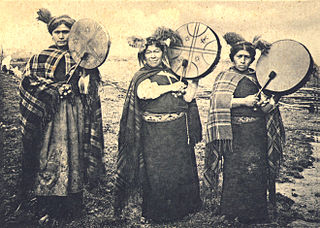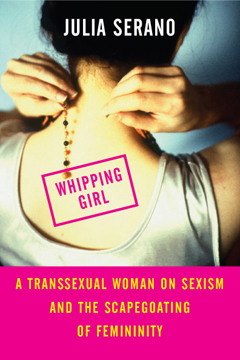Girly girl is a term for a girl or woman who presents herself in a traditionally feminine way. This may include wearing pink, using make-up, using perfume, dressing in skirts and dresses, and engaging in activities that are traditionally associated with femininity, such as talking about relationships. [1]
The term is often used in a derogatory manner, but it can also be used in a more positive way, especially when considering the fluidity of gender roles. [2] Being a "girly girl" can then be seen as a fluid and partially embodied position – a form of discourse taken up, discarded or modified for tactical or strategic purposes. [3] [4]
The female opposite of a girly girl is a tomboy. The male counterpart of a girly girl is a "man's man".[ citation needed ] The increasing prevalence of girly girls in the early 21st century has been linked to a supposed "post-feminist, post– new man construction of masculinity and femininity in mutually exclusive terms", [5] as opposed to the more blurred gender representations of previous decades. [6]
Sissy, also sissy baby, sissy boy, sissy man, sissy pants, etc., is a pejorative term for a boy or man who does not demonstrate masculine traits, and shows possible signs of fragility. Generally, sissy implies a lack of courage, strength, athleticism, coordination, testosterone, male libido, and stoicism, all of which have typically been associated with masculinity and considered important to the male role in Western society. A man might also be considered a sissy for being interested in typically feminine hobbies or employment, displaying effeminate behavior, being unathletic or being homosexual.

Tomboy is a term used for girls or young women with masculine traits. It can include wearing androgynous or unfeminine clothing and engaging in physical sports or other activities and behaviors usually associated with boys or men.

Butch and femme are terms used in the lesbian subculture to ascribe or acknowledge a masculine (butch) or feminine (femme) identity with its associated traits, behaviors, styles, self-perception, and so on. The terms were founded in lesbian communities in the twentieth century. This concept has been called a "way to organize sexual relationships and gender and sexual identity". Butch–femme culture is not the sole form of a lesbian dyadic system, as there are many women in butch–butch and femme–femme relationships.

Masculinity is a set of attributes, behaviors, and roles associated with men and boys. Masculinity can be theoretically understood as socially constructed, and there is also evidence that some behaviors considered masculine are influenced by both cultural factors and biological factors. To what extent masculinity is biologically or socially influenced is subject to debate. It is distinct from the definition of the biological male sex, as anyone can exhibit masculine traits. Standards of masculinity vary across different cultures and historical periods.

Femininity is a set of attributes, behaviors, and roles generally associated with women and girls. Femininity can be understood as socially constructed, and there is also some evidence that some behaviors considered feminine are influenced by both cultural factors and biological factors. To what extent femininity is biologically or socially influenced is subject to debate. It is conceptually distinct from both the female biological sex and from womanhood, as all humans can exhibit feminine and masculine traits, regardless of sex and gender.

Femme is a term traditionally used to describe a lesbian individual who exhibits a feminine identity or gender presentation. While commonly viewed as a lesbian term, alternate meanings of the word also exist with some non-lesbian individuals using the word, notably some gay men, bisexuals, non-binary, and transgender individuals.
"Lipstick lesbian" is slang for a lesbian who exhibits a greater amount of feminine gender attributes, such as wearing make-up, dresses or skirts, and having other characteristics associated with feminine women. In popular usage, the term is also used to characterize the feminine gender expression of bisexual women, or the broader topic of female–female sexual activity among feminine women.
Effeminacy is the embodiment of traits and/or expressions in those who are not of the female sex that are often associated with what is generally perceived to be feminine behaviours, mannerisms, styles, or gender roles, rather than with traditionally masculine behaviours, mannerisms, styles or roles. Effeminacy and other gender expressions are independent of a person's sexuality or sexual identity and are displayed by people of all sexualities and none. Effeminacy is seen in some societies as something embodied by some in the homosexual male community. The embodiment of effeminacy by people in some societies has resulted in prejudice, discrimination, antagonism and insults towards those who display it.
Gender expression, or gender presentation, is a person's behavior, mannerisms, interests, and appearance that are socially associated with gender, namely femininity or masculinity. Gender expression can also be defined as the external manifestation of one's gender identity through behavior, clothing, hairstyles, voice, or body characteristics. Typically, people think about a person's gender expression in terms of masculinity and femininity, but there are many more ways to express gender than just "man" or "woman." Gender expression can be androgynous, agender, bigender, genderfluid, genderqueer, non-binary, pangender, transgender, and other gender identities. A person's gender expression may or may not match their assigned sex at birth. This includes gender roles, and accordingly relies on cultural stereotypes about gender. It is distinct from gender identity.
A soft butch, or stem (stud-fem), is a lesbian who exhibits some stereotypical butch traits without fitting the masculine stereotype associated with butch lesbians. Soft butch is on the spectrum of butch, as are stone butch and masculine, whereas on the contrary, ultra fem, high femme, and lipstick lesbian are some labels on the spectrum of lesbians with a more prominent expression of femininity, also known as femmes. Soft butches have gender identities of women, but primarily display masculine characteristics; soft butches predominantly express masculinity with a touch of femininity.

A machi is a traditional healer and religious leader in the Mapuche culture of Chile and Argentina. Machis play significant roles in Mapuche religion. In contemporary Mapuche culture, women are more commonly machis than men, but it is not a rule. Male machi are known as Machi Weye.
Lipstick feminism is a variety of feminism that seeks to embrace traditional concepts of femininity, including the sexual power of women, alongside traditional feminist ideas. The concept emerged within the third-wave as a response to ideals created by previous movements, where women felt that they could not both be feminine and a feminist.

Machismo is the sense of being "manly" and self-reliant, a concept associated with "a strong sense of masculine pride: an exaggerated masculinity". Machismo is a term originating in the early 1930s and 1940s best defined as having pride in one's masculinity. While the term is associated with "a man's responsibility to provide for, protect, and defend his family", Machismo is strongly and consistently associated with dominance, aggression, exhibition, and nurturance. The correlation to machismo is found to be deeply rooted in family dynamics and culture.
In gender studies, hegemonic masculinity is part of R. W. Connell's gender order theory, which recognizes multiple masculinities that vary across time, society, culture, and the individual. Hegemonic masculinity is defined as a practice that legitimizes men's dominant position in society and justifies the subordination of the common male population and women, and other marginalized ways of being a man. Conceptually, hegemonic masculinity proposes to explain how and why men maintain dominant social roles over women, and other gender identities, which are perceived as "feminine" in a given society.
Feminism is a broad term given to works of those scholars who have sought to bring gender concerns into the academic study of international politics and who have used feminist theory and sometimes queer theory to better understand global politics and international relations as a whole.
Metrosexual is term describing a man in an urban, post-industrial, capitalist culture, who is especially meticulous and scrupulous about his personal style, grooming and appearance. It is often used to refer to heterosexual men who are perceived to be feminine rather than masculine and having traits typical of homosexual men. Nevertheless, the term does not assert whether a metrosexual is heterosexual, gay or a bisexual man, and the gender or sexual orientation of a metrosexual is generally ambiguous and differs in every man. Some academics consider metrosexuals to be exhibiting narcissistic tendencies.
Androgyny is the possession of both masculine and feminine characteristics. Androgyny may be expressed with regard to biological sex, gender identity, or gender expression.

Whipping Girl: A Transsexual Woman on Sexism and the Scapegoating of Femininity is a 2007 book by the gender theorist, biologist, and writer Julia Serano. The book is a transfeminist manifesto that makes the case that transphobia is rooted in sexism and that transgender activism is a feminist movement. The second edition of the book was published in March 2016.
Neofeminism describes an emerging view of women as becoming empowered through the celebration of attributes perceived to be conventionally feminine, that is, it glorifies a womanly essence over claims to equality with men. It is a term that has come into use in the early 21st century to refer to a popular culture trend, what critics see as a type of "lipstick feminism" that confines women to stereotypical roles, while it erodes cultural freedoms women gained through the second-wave feminism of the 1960s and 1970s in particular.
Gender roles in non-heterosexual communities are a topic of much debate; some people believe traditional, heterosexual gender roles are often erroneously enforced on non-heterosexual relationships by means of heteronormative culture and attitudes towards these non-conformative relationships.